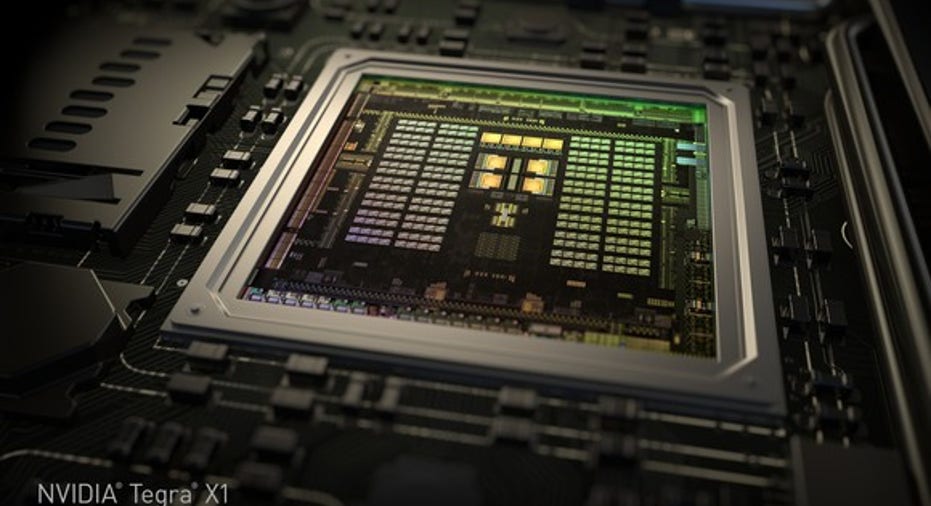Will the Nintendo NX Be a Major Windfall for NVIDIA Corporation?

Image source: NVIDIA.
Over the summer, word leaked that graphics specialist NVIDIA (NASDAQ: NVDA) would be providing the main processor for Nintendo's (NASDAQOTH: NTDOY) upcoming NX game console. At the time, I provided a very rough estimate of the financial impact that the NX could have for NVIDIA based on how the Nintendo Wii-U performed in the marketplace.
Interestingly, Digitimes recently published some information about Nintendo's build plans for the NX from "industry sources". In particular, the site says that "annual production of Nintendo NX is estimated at 9.5 to 10 million units".
Based on these numbers, it's worth providing an update to my prior estimate of what this could mean for NVIDIA from a revenue and profit perspective -- assuming, of course, that NVIDIA truly is powering the new console.
A potentially significant boost for the Tegra business
To begin, we need to have a reasonable idea of the average selling price for a high-end Tegra processor. It's hard to come up with an estimate without knowing the size of the chip, but let's suppose that it's a large chip, about the size of a competingA9X (featured in the iPad Pro) at roughly 150 square millimeters (a very high-end, graphics-heavy tablet processor) in Taiwan Semiconductor Manufacturing Company's 16-nanometer process. That is the same process that NVIDIA is likely to use to build an NX-bound Tegra. I estimated in a previous article that the A9X costs about $37.50 to produce.
Although it might be tempting to apply a 35% markup to this number -- NVIDIA does need to make a profit on the chip -- and assume a selling price of around $50, it's worth pointing out that the manufacturing technology that the A9X and next Tegra will be built on has likely matured significantly since last year. In my A9X cost analysis, I assumed manufacturing yields of around 65%. For this Tegra chip, let's dial that yield estimate up to 80%.
Based on those rough assumptions, we get a raw die cost of around $27. Add in packaging cost of $3 to $5, and total manufacturing cost should be in the range of $30 to $32 per unit. Apply a 35% markup (approximate margin for Tegra processors) to this range, and we have an average selling price of between $40 and $43.
If we assume that NVIDIA sells Tegra processors to Nintendo for $40 a piece, then NVIDIA could be looking at anywhere from $380 million to $400 million in incremental annual revenue. In fiscal 2016, NVIDIA's Tegra processor business -- which is increasingly dominated by sales of processors into automotive applications -- took in $559 million in revenue.
If Digitimes' annual Nintendo NX build estimates are accurate, and if my average selling price estimate proves reasonable, then NVIDIA could be looking at substantial revenue growth in its Tegra processor business starting in the next quarter or two.
Note that the company has previously indicated that the gross profit margins of its Tegra processors are significantly below corporate average -- I ballparked them at 35% above vs. the 57% margin the company has enjoyed in the last 12 months. Since NVIDIA is unlikely to need to spend any more to support this win if it has indeed secured it, then the graphics specialist could be looking at around $140 million in incremental operating income.
This, too, could be significant, considering that NVIDIA's operating income in fiscal 2016 came in at $747 million. An additional $100 million would mean growth of nearly 19%.
Sounds nice, but there are numerous risks
On the surface, it would seem that NVIDIA's Tegra processor business could be poised to deliver substantial revenue and profit growth in the next year. However, there are a number of risks that investors need to consider as well.
First of all, annual shipments of approximately 10 million units per year might be optimistic, considering that, as of earlier this year, the Wii-U barely cleared 13 million in lifetime unit sales. Annual unit shipments of the new console might fall significantly short of expectations if the console is poorly received in the marketplace.
Beyond that, while I believe my average selling price estimates for Tegra processors are reasonable, they are still only estimates. A significant deviation in the actual number could drive revenue from this deal downward (or upward).
And, of course, the final risk -- and by far the most important one -- is that despite the multiple reports from credible sources, NVIDIA might not have actually won a place in the Nintendo NX.
The good news is that Digitimes says trial production of these new consoles has already begun, so the formal launch shouldn't be too far off. Investors should be able to get a clearer picture soon enough.
A secret billion-dollar stock opportunity The world's biggest tech company forgot to show you something, but a few Wall Street analysts and the Fool didn't miss a beat: There's a small company that's powering their brand-new gadgets and the coming revolution in technology. And we think its stock price has nearly unlimited room to run for early in-the-know investors! To be one of them, just click here.
Ashraf Eassa has no position in any stocks mentioned. The Motley Fool owns shares of and recommends NVIDIA. Try any of our Foolish newsletter services free for 30 days. We Fools may not all hold the same opinions, but we all believe that considering a diverse range of insights makes us better investors. The Motley Fool has a disclosure policy.



















